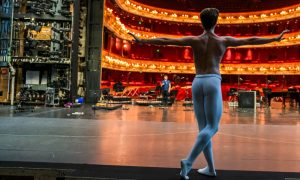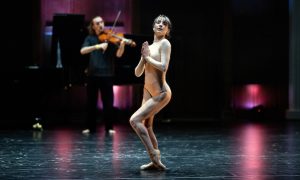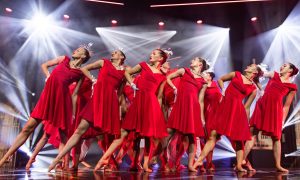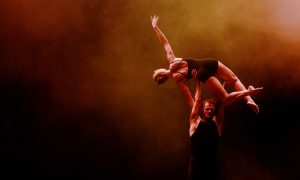Ballet star Steven McRae returns to the Royal Opera House for his 20th season with The Royal Ballet. Having recently returned from Japan, Dance Informa had the privilege of catching up with McRae between rehearsals to talk about the importance of acknowledging one’s journey, the lessons learnt over the years, family schedules and celebrating victories.
Join us, as we dive deep into conversations that serve as a catalyst for the industry’s framework and inspiring moments which pave the way for upcoming generations.
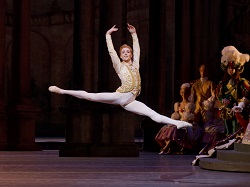
Steven, as you return from Japan and summer break, and you enter into your 20th season with The Royal Ballet, how would you describe your current mindset?
“I’m honestly in a very good place. The tour to Japan with the company was a very special moment, not only for myself but for the entire company. It’s been a while since we’ve toured anywhere, and it is a very special place for a lot of us dancers as we have performed there several times. So, to be starting my 20th season with the company – having just come back from Japan – feels like a nice full-circle moment!
We performed Romeo and Juliet, which was the first full-length ballet I ever performed with The Royal Ballet when I was very young, and then it was also the ballet that I returned to after snapping my Achilles tendon and was my first ballet back on stage almost two years ago. So, to return to Japan feeling physically and mentally stronger – and far more confident – was a nice moment for me, my medical team and Kevin O’Hare. He’s been incredibly patient letting me navigate this difficult path back on stage, and it hasn’t been a straightforward process. However, I feel that moment in Japan was a nice moment for us all to acknowledge that I am back!”
It’s been an incredible journey to witness along with the support from your gorgeous family. What were your favourite holiday activities to do with Elizabeth, Audrey, Frederick and Rupert over the break?
“Realistically, I only really had one week off with them. The school holidays and our rehearsal holidays from the company don’t coincide that much. I had some extra work in Denmark with Verdensballetten, as I’m the Artistic Director of a series of shows that we do outdoors in Denmark, so I was very busy planning those. Nevertheless, I would have to say the most enjoyable things are the simple things, like paddling in the pool in the afternoon, going and getting an ice cream, or a day trip to the beach. For me, those are the moments that are the most special, where all our focus is purely on each other and the activity that we’re doing at that time – we’re not busy planning this event or that show tomorrow, or that the kids have homework due. When you can strip everything away and do the most simple of activities, that for me is heaven. I mean, give me a box of Legos, and I’ll sit and play with the children for two hours and I’m the happiest I possibly could ever be.”
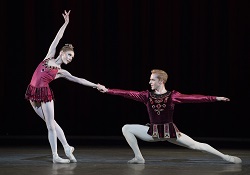
How old are the children now, and what are their interests?
“My daughter Audrey is eight, Frederick is six and Rupert has just turned four, and they’re all into lots of things. They’re all naturally, I think, quite theatrical in some way. They all love music, and they all love to express themselves. If there’s music on, we encourage them to just absolutely be free and do whatever the music is making them feel.
They’re very energetic children and quite athletic. They love to do a bit of tennis. My daughter also does a bit of netball. My youngest is probably going to want to do football and he’ll start school this year. I’m just excited for them to see what their futures hold, and I guess to expose them to as much of the world as possible. Thankfully, here in London, you do feel like there’s a whole melting pot of the entire world. They’re very fortunate that they are growing up in a city where they are exposed to multiple walks of life.”
How do you and Elizabeth juggle parenthood and the demands of professional ballet? What was your secret during those early years of parenthood – those sleep deprivation years – and how did you stay in peak condition?
“I mean, there’s just no way to sugarcoat it. It’s just incredibly difficult and highly demanding. My family are all in Australia, and my wife’s family are in Yorkshire, which is a five-hour drive from here. So, we have no family support around the corner, and there’s no one to call at the last minute. That doesn’t exist in our world.
My wife is an absolute superwoman and managed to get back on stage each time, and we learnt how to work as a team. Our hours are just so ridiculous and they’re not hours that you can plan a normal week around – each week is different, and every schedule is different. Sometimes, you’re leaving the house at eight o’clock in the morning and not returning until midnight. To have childcare for that is just impossible and extortionate here in the UK. We had to have a live-in nanny which was insanely expensive, but it was practically the only way that the two of us could continue performing and pursuing our careers.
After baby number three was born, I snapped my Achilles tendon – five weeks after he was born – so it was a very intense time. I was unable to move for months, and my wife was training to get back to go on stage after baby number three. So, we started that whole juggling act and then the world went into lockdown. The practicalities of having a four-year-old, a two-year-old, a newborn and a husband who couldn’t walk because his career was dangling by a thread was a challenge.
It was a highly intense situation. We had no nanny during lockdown. It was just my wife and I at home. I was trying to rehab via Zoom, she’s trying to train via Zoom, and then we started homeschooling. We were both trying to get back on stage. It was a lot! I think my wife and I – if I’m honest – are very good at working as a team and just get it done, move on and go on to the next thing.”
Would you say the industry is conducive to family life?
“Having children was something that we’ve both dreamt of and both been very passionate about from a young age. Unfortunately, the profession tolerates parenthood, but it doesn’t accommodate it in any way at the moment. We’re all trying to work hard to make sure that those changes do happen in the future. However, it’s still not compatible with parenthood.
We also knew that the repertoire would be a lot of repertoire that my wife had already done for many, many years. For her, the practicality of doing endless runs of Swan Lake, Sleeping Beauty, and The Nutcracker didn’t weigh up what she would then be missing from the children. So, she decided at that point, when the Opera House reopens, that she would finish up and move on. She made that decision for us as a household – I was truly admirable that she did that. It’s honestly been the greatest thing as it’s created that extra security and that little bit of sense of calm – as much as you can have calm with three young children in the house.
What she did in those early years, having our daughter and then getting back on stage, and then having our son and getting back on stage, and then getting pregnant again is truly inspiring because she did it in such a professional way. She didn’t pop the baby out and race back to get into the studio. She also didn’t take years to get back on stage. I feel that she did it in as healthy a way as possible, and she most certainly has had a positive impact on those generations now who will follow in her footsteps.”
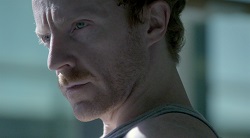
Yes, it is very inspiring, and I’d be interested in having a conversation around this topic on a deeper level because everyone’s path is distinctly unique. Looking back over the years with The Royal Ballet, can you talk about your three top highlights?
“The first one would have to be performing Sir Kenneth MacMillan’s production of Romeo and Juliet for the first time with Alina Cojocaru (OBE). I was very young in the company, and I had five days to learn the whole ballet. I did the opening night with her, and I think that has to honestly be one of those top moments because I was so young. I had no concept of what it took to lead a full-length ballet, and Romeo and Juliet has beautiful partnering and difficult solos.
The second would be developing the partnerships that I’ve been able to develop with people like Sarah Lamb, Iana Salenko, and more recently, I’ve been doing quite a lot with Anna Rose O’Sullivan as well. I think that the opportunity to create those special partnerships is – to be honest – a real honour. You find that connection with somebody, and it grows that relationship. It becomes apparent on stage when you’re watching that these two people are genuinely communicating the whole time. They’re not just dancing together, but they are at one together.
The third, and it’s ironic to say, but my whole injury and returning to the stage. Oddly still has to be one of the highlights because I’m incredibly proud of what we were able to achieve collectively with the medical team. It defied all the odds. Virtually, nobody believed that I would get back on that stage. So, I think although it started as a horrible situation, we were able to flip that around and use it for the greater good.”
Throughout the recovery process, you’ve been involved in the film, A Resilient Man, directed by French film-maker Stéphane Carrel. Can you tell us about how your journey was captured and the process of creating the film?
“I was contacted by the director, Stéphane Carrel. He had made a documentary film about the fashion designer Paul Smith, a very private man. When I heard that Stéphane had made a documentary on Paul Smith who I’ve met, I thought, ‘Okay, I want to meet this director because he has a way of filming that people feel safe with and feel comfortable with.’ So, when he reached out to me, I agreed to do something. But I hadn’t snapped my Achilles at that point. Then after the injury occurred, he contacted me and said, ‘Well, there we go, there’s our story!’
He was going to come to London, and start filming the week that we went into lockdown. So, we had to adjust the arc of the film. We were going to focus on the whole recovery up to that first show, but that was not an option because he couldn’t get here to film for almost all of my recovery. So, we filmed some scenes with my cameras, but we decided to film my entire first season back because we also knew with the medical team the goal was to get me back on stage. In saying that, once you’re back on stage, it’s another journey to stay on stage. Each ballet throws a new set of demands your way.
We filmed the whole season which included a bit of Romeo and Juliet and Nutcracker which I was preparing for and two days before I had to pull out. I then did Swan Lake and Rhapsody by Frederick Ashton – which also happens to be the most demanding male role you could do. I was determined to do it after my Achilles snapped, which I did, and that’s in the film. So, it touches on the practicalities of getting back on stage, but also on the huge journey I had to go on re-educating myself about it. We looked at how I had been working, how the profession functions, and in many ways not in a good way. We need to alter the culture surrounding it. I went through all of this journey because I was surrounded by people who were open to sharing their knowledge and wisdom.”
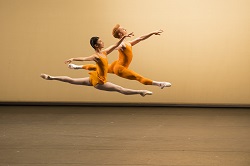
Who were the key influences during your recovery journey, and what realisations surfaced?
“I work religiously now with a Sports Scientist Gregor Rosenkranz who has been by my side throughout this entire process. He has devised programs with the physiotherapists and the doctors to get me functioning and walking again. He’s also had to be the psychologist, the nutritionist, the general advisor on everything. I’ve been lucky and worked with Leanne Benjamin (former Principal), and she’s now one of our coaches and coached me to get back on stage.
The film touches on a lot of these difficult topics. I started to open up about it because there was a realisation that I had been working for years in a state of burnout. I was unaware of exactly what that was – I was not able to identify that I was in that state. I had feared that I was just falling out of love with dance. But I wasn’t; it was burnout. It was me not listening to my body and my mental health. These are all things that are difficult to acknowledge and open up about.
Ultimately, I said I wanted this film to be hopeful. The film touches on some horrible moments. I’m there, what looks like flying high in my career, and then all of a sudden, it’s all dangling by a thread. I want it to be a message that there are dark times. There are horrible times. There are times when you feel like you have no control over them because there is no guarantee it will go the way it’s all planned. I just hope that it gives people that sense that there is a light at the end of the tunnel somewhere.”
Did you find now when performing you’re much more conscious and aware of your body?
“It’s not necessarily in the performance aspect, it’s more in the preparation process. I’ve changed my weekly schedule. Now on Wednesdays, I almost do nothing purely because no athlete would ever be expected to train in peak condition six days a week, 52 weeks of the year. The world of athletics – or any athlete and sports scientists – would just laugh and shake their head and be like, ‘Well, that’s just ridiculous, that’s not possible.’ But in the world of dance, that’s still the culture we surround ourselves in. So, I’ve made a shift with that, and for the last two years, I’ve not trained much on a Wednesday. It’s been more the preparation aspects that have changed and shifted, and I’m far less stubborn and more aware of looking at the bigger picture in the sense of planning around different workloads.
In the sense of the performance aspect, a lot of fear was involved. It’s only really in the last six months that fear has reduced. It doesn’t matter how many psychologists you work with; you’re still going to be dealt with flashbacks and doubts in your mind. However, if you can be open about it, then there are people out there who can offer you support and tools to navigate those situations when they come up, so that when those flashbacks return, you know how to deal with them and move on.”

Absolutely. It’s not just the physical recovery but the psychological recovery as well. What message do you want people to walk away with after seeing the film?
“First of all, you’ve got the dance world, whether that’s ballet or any style of dance. I hope it’s a catalyst for sparking more conversation around how we treat dancers, how we prepare for productions and performances, and how we coach people. This includes the mentality behind it, the terminology we use, how we structure seasons and how we share workloads. I hope these kinds of conversations come to the forefront after this.
It’s also an opportunity to celebrate what people like Kevin O’Hare – who are leading us at The Royal Ballet – are trying to do and what they are trying to implement. Of course, within the restraints of still trying to satisfy box office, and stakeholders, and keep everybody employed. For me, it’s also to celebrate how Kevin handled the situation, to be honest. He was the one who flicked the switch in my head. Twenty minutes after my Achilles snapped on stage, I was in this dressing room. I’d had three surgeries in the 12 months leading up to that show and I genuinely thought, when it snapped, ‘Come on, this is it!’ Like, ‘This is it! It’s over now!’ However, it was Kevin who sat in here (the room I happen to be in right now) and looked me in the eye and said, ‘No, you will get back on stage. We will get you back onto that stage.’ So, I only spent those first 20 minutes thinking, ‘This is over, it’s over,’ because my head instantly went into, ‘Oh, okay, right, so we’re on that mission now. Let’s get this done.’ The film is also for me to thank him, and thank the company for that support, in the hope that it becomes the norm for companies around the world, and that dancers are respected, dancers are protected, nurtured and cared for appropriately.”
There’s so much work to be done and so much conversation to have around this shift. Can you give us a little glimpse of what’s on the slate and what’s upcoming?
“The film will be out during this season. As soon as we have dates, everybody will know straight away. In terms of here at The Royal Ballet, I have quite a big season. A lot of the big ballets such as Don Quixote, Nutcracker and Manon. That’ll be the first time dancing it since my injury, as it was during Manon that I snapped my Achilles. So, that is going to be a big moment! I’m going to be preparing psychologically just as much physically for that moment.
We also have the return of Swan Lake and other demanding and challenging works, as well as some new works. So, a lot will be happening. Then, in the summer, I will also be planning these shows that I do in Denmark every summer, and that’s always an annual highlight. It’s a beautiful series of outdoor shows, in beautiful venues, surrounded by many of my friends. It’s a special event to be part of. It’s something I wish we could share with more audiences around the world because it’s such a beautiful way of introducing people to dance, music and opera in a very relaxed setting. It’s all about having that dialogue with the audience and introducing people to those live art forms.”
Yes, that’s right, and it removes the barrier to entry. What’s your number one goal?
“For me, it’s just all about my family, all about my children, and ensuring that they can flourish and be happy kids who enjoy exploring the world around them. That’s always my constant goal, every single day when I wake up, and I try to facilitate that for them.
On a side note, it would be nice to have a family holiday – that would be nice! Ultimately, it’s just being as healthy and positive as I possibly can be and ensuring that I continue to do what it is that I love.”
Steven McRae’s upcoming performances with The Royal Ballet are:
Don Quixote: 7 October 1pm; 13 October 7:30pm; 17 October 7:30pm
The Nutcracker: 18 December 7:30pm; 22 December 1:30pm
Manon: 26 February 7:30pm; 2 March 1pm
For tickets and more information on The Royal Ballet, visit www.roh.org.uk/about/the-royal-ballet.
By Renata Ogayar of Dance Informa.





